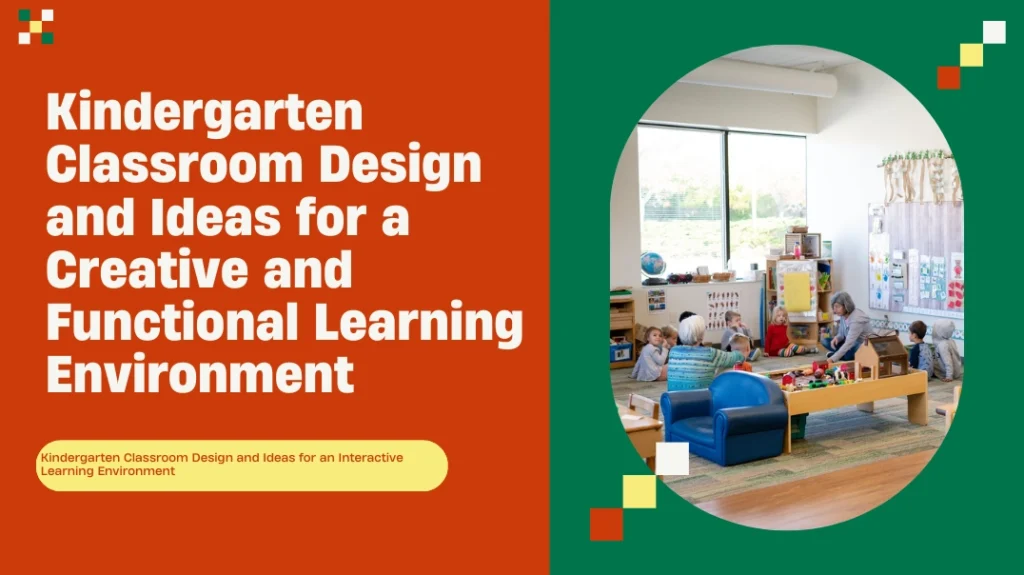Creating the perfect kindergarten classroom can be challenging. Are you struggling to find the best ways to design a classroom that fosters learning and creativity while maintaining functionality? Let’s explore some essential tips and ideas to transform any kindergarten classroom into an engaging and efficient space.
Designing an effective kindergarten classroom involves a combination of creativity, practicality, and understanding of children’s needs. Here are 15 best practices to help you create an ideal learning environment.
Are you intrigued by how simple changes can make a big difference in your classroom setup? Read on to discover more.
Essential Elements of Kindergarten Classroom Design
Ensuring Safety and Accessibility
Creating a safe and accessible kindergarten classroom fosters a secure learning environment where children can thrive. Safety measures should be at the forefront of classroom design, starting with the physical layout. Clear pathways free of obstructions ensure students can move around quickly and safely, reducing the risk of trips and falls. This is especially important in a kindergarten classroom where children are often on the move.
Anchoring heavy furniture, such as bookshelves and cabinets, to the walls is another essential safety measure. This prevents them from tipping over if a child climbs on them or during an earthquake. Using non-toxic materials for furniture and finishes is critical for safeguarding children’s health. Children are susceptible to harmful chemicals, so selecting products free from volatile organic compounds (VOCs) and other toxins is necessary.
Accessibility is essential, ensuring that all students, including those with disabilities, can participate fully in classroom activities. This includes having accessible bathrooms and sinks at the children’s height, making it easier for them to develop independence in personal hygiene. Safety equipment, like fire extinguishers and first aid kits, should be easily accessible and regularly maintained. Training teachers and staff on emergency procedures ensures they can respond quickly and effectively.
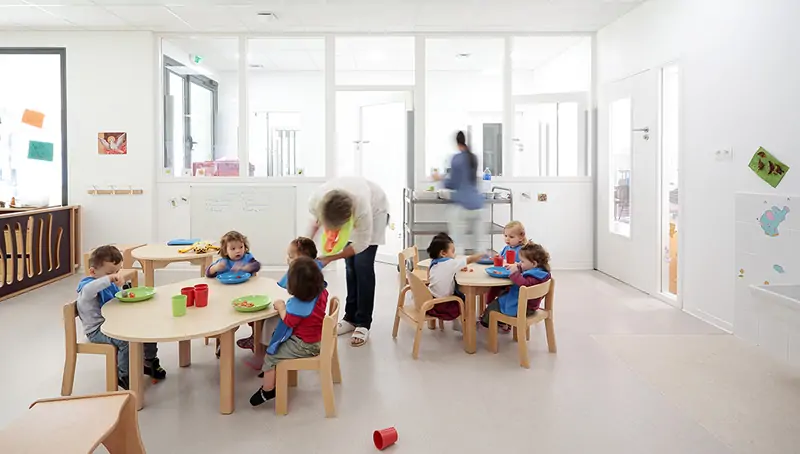
Creating Flexible Learning Spaces
In the dynamic environment of a kindergarten classroom, flexibility is critical to accommodating various teaching methods and learning activities. Flexible learning spaces allow for a seamless transition between different types of learning, from group projects to individual tasks. This adaptability is achieved through movable furniture and multi-purpose areas, which can be easily reconfigured to meet the moment’s needs.
Movable furniture, such as lightweight tables and chairs, allows teachers to rearrange the classroom layout to support different activities quickly. For instance, tables can be grouped for collaborative projects or separated for individual work. Multi-purpose areas can serve as reading corners, art stations, or science experiment zones, depending on the lesson plan for the day.
Such flexibility encourages teachers to adopt diverse teaching methods, catering to different learning styles and needs. For example, a teacher might start the day with a circle time activity that fosters social interaction and then transition to hands-on learning at various stations around the room. This approach keeps children engaged and allows them to explore different ways of learning.
Incorporating flexible seating options, like bean bags, floor cushions, and standing desks, allows children to choose where and how they learn best. This autonomy can enhance their focus and comfort, providing a more effective learning experience. Additionally, having designated areas for quiet reading, creative play, and active exploration helps manage classroom noise and activity levels, creating a balanced environment conducive to learning.


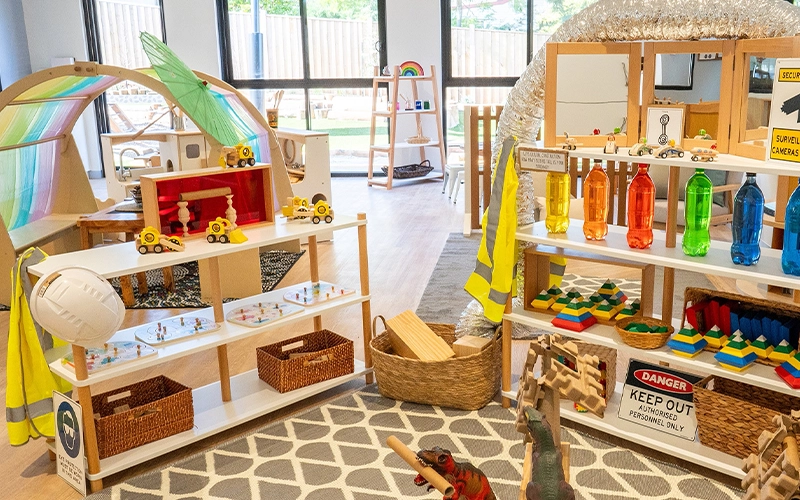
Choosing Age-Appropriate Furniture
Selecting age-appropriate furniture is fundamental in designing an effective kindergarten classroom. Furniture the right size for children promotes proper posture, comfort, and ease of use, essential for maintaining focus and engagement during learning activities.
Chairs and tables should be comfortable for kindergarten students, allowing their feet to rest flat on the floor and their arms to reach the tabletop easily. This promotes good posture and reduces strain on their developing bodies. Adjustable furniture can be handy, as it can be modified to fit the varying heights of children in the classroom.
Durability and safety are also critical considerations when choosing classroom furniture. Furniture should be built to withstand the wear and tear of daily use by energetic kids. This includes selecting materials that are easy to clean and maintain and ensuring that all furniture has rounded edges to prevent injuries. Stable construction is vital to prevent tipping, especially for items like bookshelves and storage units.
Beyond the basics of tables and chairs, incorporating a variety of seating options can enhance the learning environment. Soft seating areas, like bean bags or floor cushions, provide comfortable spots for reading and quiet activities. Standing desks and floor tables offer alternative workspaces that accommodate different learning preferences and activities.
Additionally, having child-sized storage solutions, such as cubbies and low shelves, encourages independence as children can easily access and put away their materials. This helps keep the classroom organized and teaches children responsibility and self-management skills. Labels and pictures on storage bins can further assist children in identifying where items belong, fostering a sense of order and routine.
Investing in age-appropriate, durable, and safe furniture tailored to children’s needs is essential for creating a kindergarten classroom that supports active, comfortable, and engaged learning. By carefully considering the furniture’s physical design and how it fits into the broader classroom environment, educators can create a space that nurtures and inspires children.
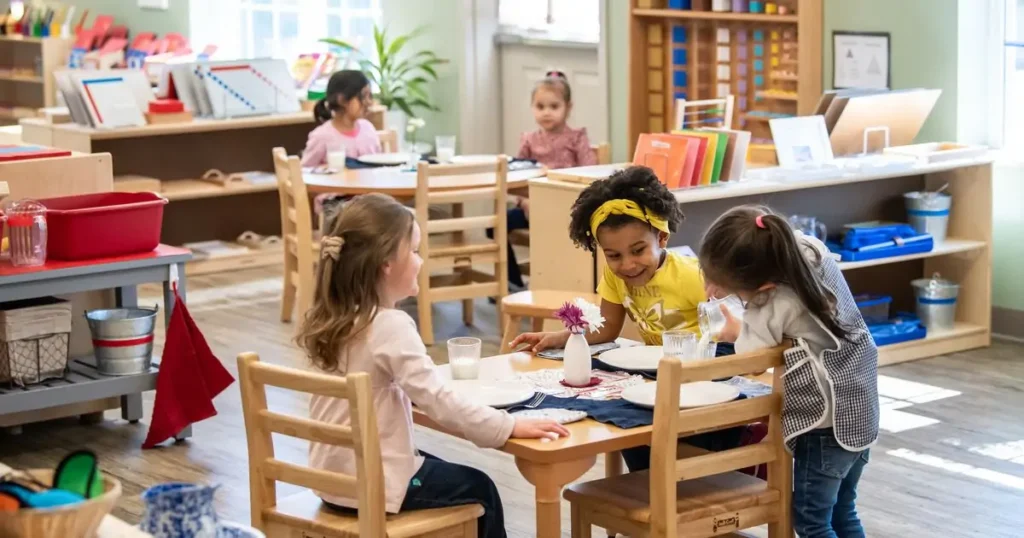
Creative Ideas for Kindergarten Classroom Design
Designing an effective and engaging learning space for children goes beyond choosing the right furniture or color scheme. A well-planned classroom design fosters creativity, exploration, and engagement, making early learning environments more effective. Whether you are designing a kindergarten classroom, a preschool learning center, a daycare facility, or an early learning center, incorporating creative elements can significantly enhance the educational experience.
Below are innovative classroom design ideas for kindergarten and other early childhood settings that promote learning, social interaction, and hands-on exploration.
Themed Classroom Design for Engaging Learning Environments
A themed classroom can transform an ordinary space into a dynamic and exciting learning environment. Whether in a kindergarten, preschool, daycare, or early learning center, a well-designed theme helps children engage with their surroundings, encourages imaginative play, and makes learning more interactive. Below are four creative classroom design ideas for kindergarten and other early childhood spaces that bring learning to life.
Nature-Inspired Classrooms
A nature-themed classroom creates a calm, refreshing environment that fosters curiosity and exploration. Bringing natural elements into a school can help children feel more connected to the world around them.
- Use earthy colors like green, brown, and sky blue for walls and decorations.
- Add tree-shaped bookshelves, hanging vines, or murals of forests and animals.
- Place indoor plants to introduce real greenery and improve air quality.
- Include a nature exploration corner with magnifying glasses, leaves, and small rocks for hands-on learning.
- Create a camping or outdoor adventure reading area with tents, artificial grass, and soft lighting.
This theme works well in preschool classrooms and early learning centers where educators emphasize hands-on discovery and sensory experiences.
Underwater Exploration
An ocean-themed classroom can spark children’s curiosity about marine life and water ecosystems. The deep blue tones and playful sea creatures make the classroom exciting and inviting.
- Use blue tones for walls and add wave patterns or ocean murals.
- Hang paper fish, jellyfish, or seaweed decorations from the ceiling.
- Include a “submarine” reading nook with soft seating inside a cardboard or wooden submarine.
- Set up an aquarium corner with real or artificial fish to engage children with marine life.
- Create a water sensory station where kids can play and learn about floating, sinking, and water movement.
This theme is ideal for daycare centers and preschools where sensory learning plays a key role in development.
Space-Themed Classrooms
A space classroom theme encourages children to think beyond the world they see and explore concepts of planets, stars, and astronauts. This theme is perfect for fostering an interest in science and discovery.
- Paint the ceiling dark blue with glow-in-the-dark stars and planets.
- Hang 3D models of planets, rockets, and satellites from the ceiling.
- Set up a “Mission Control” center with computers, buttons, and space maps for imaginative play.
- Create a “moon surface” sensory area with silver mats, textured rugs, or kinetic sand.
- Provide astronaut costumes and helmets for role-playing activities.
A space classroom design works well in early learning centers and STEM-focused kindergartens, where science and exploration are priorities.
Mini City Setup
A mini-city classroom brings real-world experiences into the learning environment, helping children understand societal roles through pretend play.
- Design areas like grocery stores, post offices, hospitals, or restaurants where children can role-play.
- Use signs and labels to make the setup feel like a real town.
- Provide costumes and props to encourage children to take on different roles.
- Use small tables and chairs to create “workstations” for different jobs.
- Introduce simple math and reading activities related to daily life, such as counting play money in the store or writing letters in the post office.
This theme fits preschool classrooms and daycare centers where social skills and interactive learning are key.
Themed classrooms are a great way to make learning fun and engaging. Educators can create a space that supports creativity and academic growth by choosing a theme that resonates with children’s interests. If you’re looking for more preschool classroom themes, check out this guide on classroom themes for additional inspiration.



Interactive Learning Spaces for Daycare Classrooms
Interactive learning spaces help young children explore, discover, and engage with their surroundings. A well-designed daycare classroom, preschool learning center, or early education space should include areas that promote hands-on activities and sensory experiences. These spaces encourage creativity, problem-solving, and teamwork. Below are four key ways to make a classroom more interactive.
STEM Exploration Corners
STEM (Science, Technology, Engineering, and Math) activities allow children to experiment and learn through play. A STEM corner can help build critical thinking and early problem-solving skills.
- Provide building blocks, magnetic tiles, and simple engineering kits to encourage hands-on construction.
- Set up a sink or water table for science experiments, such as floating and sinking activities.
- Include a “cause and effect” station with pulleys, ramps, and gears.
- Offer coding games with simple robotic toys designed for young learners.
Sensory Play Areas
Sensory play helps children develop fine motor skills and process information from their environment. A well-planned sensory area can stimulate curiosity and exploration.
- Use a sand or water table with tools like funnels, scoops, and sieves.
- Provide bins filled with textured materials such as rice, beans, soft fabrics, or kinetic sand.
- Create a light table station with translucent objects for children to explore colors and shapes.
- Offer sound-based activities like musical instruments or interactive noise-making toys.
Movable Learning Centers
A flexible classroom setup allows teachers to change the learning environment based on different activities. Movable centers make the space more adaptable and encourage collaborative play.
- Use lightweight tables and rolling storage bins to quickly reconfigure spaces.
- Create modular seating areas where children can quickly gather for group activities.
- Offer portable whiteboards or chalkboards so children can brainstorm and draw anywhere.
- Provide stackable cushions and mats for a cozy reading or quiet area.
Wall-Mounted Interactive Boards
Interactive boards help children practice writing, drawing, and hands-on learning in a fun way. These boards can also make the most of vertical space in smaller classrooms.
- Install a chalkboard or dry-erase board for children to draw and practice letters.
- Use magnetic walls where kids can attach letters, numbers, or story sequencing cards.
- Set up a felt board with removable characters for storytelling activities.
- Provide a large puzzle or matching game board for problem-solving practice.
By incorporating these interactive learning spaces, teachers can create an environment that supports exploration, creativity, and hands-on learning in daycare and preschool classrooms.


Your perfect classroom is one click away!
Integrating Smart Technology into Early Learning Centers
Technology can enhance learning when used in a balanced way. Innovative technology can help make lessons more engaging and interactive in preschools, kindergartens, and early learning centers. Below are three ways to incorporate technology into an early childhood classroom.
Interactive Projection Walls
Projection walls turn any surface into an interactive space, allowing children to engage with digital content through movement and touch. These walls can be used for a variety of educational activities.
- Display alphabet and number games where children can touch and move objects.
- Create virtual storytelling experiences with animated characters.
- Use motion-based activities to encourage movement and coordination.
- Introduce science simulations, like watching animals in their natural habitats.
Smartboards for Storytelling and Learning
Smartboards allow teachers to create interactive lessons that combine visuals, sounds, and hands-on activities. These boards encourage collaboration and make learning more dynamic.
- Let children drag and drop pictures or letters to complete words and sentences.
- Display digital books with animations to bring stories to life.
- Introduce drawing and creativity apps where children can design and color on the screen.
- Play music and rhythm games to develop early math and pattern recognition skills.
Voice-Activated Learning Assistants
When used appropriately, devices like Amazon Alexa or Google Assistant can be useful tools for early education. They help answer children’s questions and introduce interactive learning activities.
Ways to Use Voice Assistants in a Preschool Classroom:
- Ask questions like, “Tell us a fun fact about space!” or “What sound does a lion make?”
- Play interactive storytelling games where children help decide what happens next.
- Set up daily routines by using timers and reminders for transitions.
- Play learning songs and nursery rhymes to support language development.
Innovative technology should always be used in moderation and as a supplement to hands-on learning. Integrating thoughtfully can make kindergarten, preschool, and daycare classrooms more engaging and interactive.
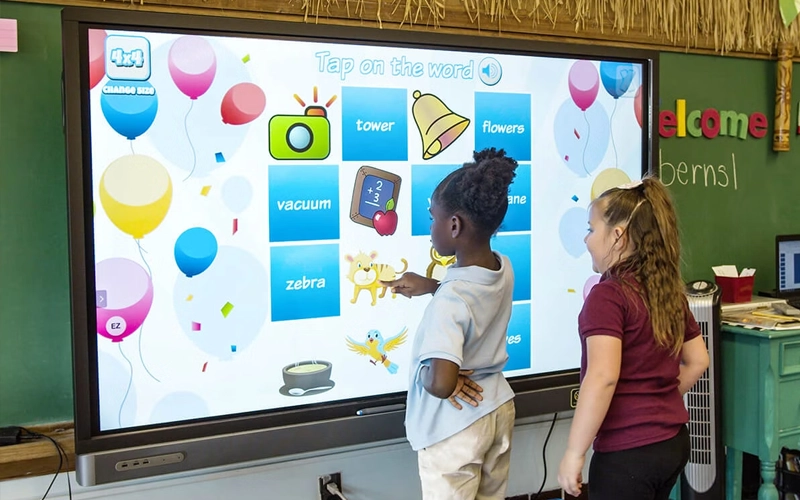

Creative Arts and DIY Zones in Preschool and Daycare Classrooms
Creative activities help children develop fine motor skills, self-expression, and problem-solving abilities. A well-designed arts and DIY area in a preschool, daycare, or early learning center encourages exploration and hands-on learning. Below are three ways to create an inspiring creative space.
Dedicated Art Walls
An art wall allows children to display their work and encourages creativity proudly. Seeing their work on the wall builds confidence and motivation.
| How to Set Up an Art Wall | Why It Works |
|---|---|
| Install a large corkboard or magnetic board for easy artwork display. | Makes children feel valued and appreciated. |
| Use clipboards or wire grids to create a rotating gallery of student work. | Allows for quick and easy updates. |
| Add frames or borders to highlight individual pieces. | Helps create a sense of organization and importance. |
| Provide chalkboard or whiteboard sections for free drawing. | Encourages spontaneous creativity. |
Recycled Craft Stations
A craft area with recycled materials teaches children about sustainability while encouraging creativity. Instead of buying new supplies, children can reuse and repurpose everyday materials.
| Materials to Include | Creative Uses |
|---|---|
| Cardboard boxes | Build houses, cars, and robots |
| Bottle caps and buttons | Create mosaics and counting games |
| Old magazines | Cut out pictures for collages |
| Fabric scraps | Make puppets or patchwork art |
| Egg cartons | Create animal models or plant starters |
Encouraging children to think outside the box and use materials in new ways fosters imagination and problem-solving skills.
Performance Stages
A small performance space allows children to build confidence through drama, storytelling, and music.
- Set up a mini stage area with a small rug or raised platform.
- Provide costumes, hats, and props for role-playing.
- Include puppets and a puppet theater for storytelling.
- Install a simple curtain or backdrop to make performances feel special.
- Add a microphone or small speaker to encourage singing and public speaking.
These performance areas encourage children to express themselves, work together, and develop language and social skills.
Don’t just dream it, design it! Let’s chat about your custom furniture needs!
Outdoor and Nature-Inspired Spaces for Learning Centers
Outdoor learning spaces offer children hands-on experiences with nature and help them develop physical skills, curiosity, and environmental awareness. Whether designing a kindergarten, preschool, or daycare outdoor area, these ideas make outdoor learning more interactive and meaningful.
Mini Garden Learning Spaces
A garden area teaches children about plant life, responsibility, and patience. Caring for plants helps them understand how things grow and connects them with nature.
- Use raised garden beds or small pots for easy access.
- Let children plant flowers, herbs, or vegetables and care for them daily.
- Add labels and signs to help children learn plant names.
- Introduce a worm compost bin to teach about soil and recycling.
- Set up a watering station with small cans or spray bottles.
Outdoor Chalkboard Walls
A chalkboard wall outside allows children to draw, write, and explore creativity in the fresh air. This is a great way to use outdoor space without requiring additional materials.
| Benefits of Outdoor Chalkboard Walls |
|---|
| It can be used for outdoor learning activities |
| Helps children practice writing and letters |
| Allows for collaborative art projects |
| It can be used for outdoor learning activities |
To set one up, install a large wooden board painted with chalkboard paint or use removable panels. Keep a bucket of colorful chalk nearby for children to use freely.
Nature Exploration Kits
Nature kits help children observe, collect, and study outdoor elements, turning outdoor time into an interactive learning experience.
| Items to Include in a Nature Kit | Purpose |
|---|---|
| Magnifying glasses | Observe leaves, bugs, and textures up close |
| Binoculars | Spot birds, clouds, and distant objects |
| Small containers | Collect leaves, flowers, or interesting rocks |
| Field guides or picture books | Identify plants and insects |
| Clipboards with paper | Draw or take notes about discoveries |
Encouraging children to ask questions and explore helps develop scientific thinking and curiosity about the world around them.
Integrating arts, hands-on creativity, and outdoor learning spaces in a preschool, daycare, or kindergarten makes learning more engaging and interactive. Educators can create a well-rounded environment that nurtures creativity, curiosity, and exploration by providing art walls, recycled craft stations, performance areas, mini gardens, chalkboard walls, and nature kits.
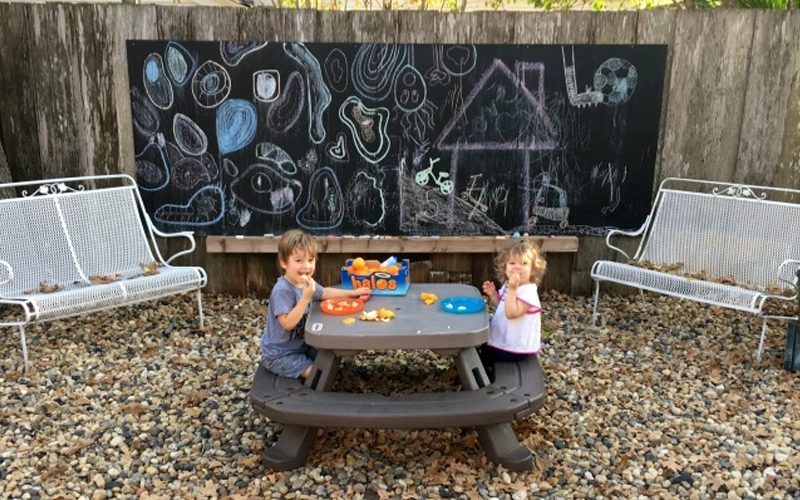
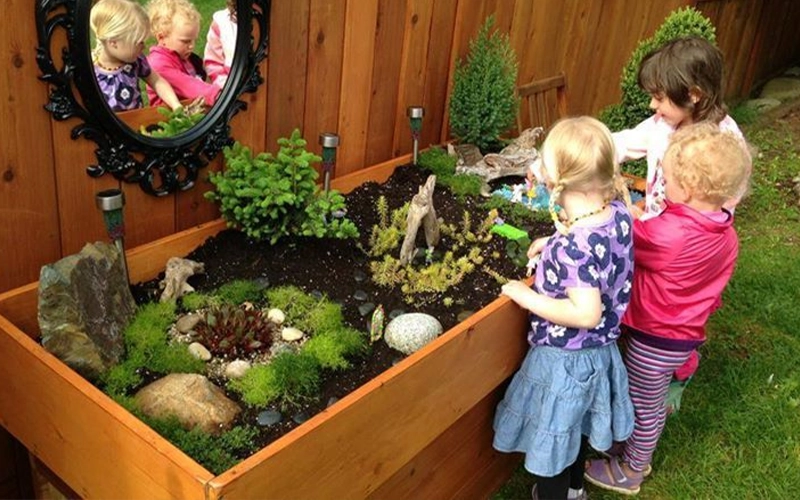
Cross-Disciplinary Learning Spaces in Kindergarten and Preschool Classrooms
Creating cross-disciplinary learning spaces allows children to explore multiple subjects connected and engagingly. Instead of separating subjects like science, math, and the arts, these spaces blend different areas of learning, helping children develop problem-solving skills and a deeper understanding of the world. Below are three effective ways to incorporate cross-disciplinary learning into preschool, kindergarten, and early learning centers.
STEAM Labs
STEAM stands for Science, Technology, Engineering, Arts, and Mathematics. A STEAM lab hands-on integrates these subjects, encouraging children to experiment and explore.
| Activity | What It Teaches |
|---|---|
| Building structures with blocks or recycled materials | Engineering, spatial awareness, and problem-solving |
| Mixing colors with water or paint | Science, art, and observation skills |
| Creating simple circuits with battery packs and LED lights | Technology and early electronics |
| Using balance scales to measure different objects | Math and scientific reasoning |
A well-organized STEAM lab should include open-ended materials, like building blocks, art supplies, and measuring tools, so children can test their ideas and develop creativity.
Music and Math Connection
Music and math are closely linked, involving patterns, counting, and rhythm. A music and math area can help children understand numbers through movement and sound.
Ideas for a Music and Math Area
- Rhythm and Counting – Have children clap or play instruments to match different numbers or patterns.
- Musical Measurement – Use different strings, pipes, or xylophone key lengths to show how size affects the sound.
- Pattern Recognition – Create songs using repeating patterns, helping children recognize sequences.
- Number Songs and Dance – Incorporate movement with songs that teach numbers, shapes, and directions.
Children develop a stronger sense of numbers by combining math concepts with music and movement while having fun.
Role-Playing Learning Centers
Role-playing helps children practice real-world skills in a safe and imaginative environment. A well-designed role-playing center allows children to act out different scenarios, helping them develop communication, problem-solving, and social skills.
| Role-Playing Theme | What Children Learn |
|---|---|
| Grocery Store | Counting money, organizing, and teamwork |
| Doctor’s Office | Empathy, communication, and basic health knowledge |
| Construction Zone | Engineering, problem-solving, and coordination |
| Animal Rescue Center | Responsibility, animal care, and role-playing skills |
Provide simple props, costumes, and real-world tools that encourage interaction and storytelling to make a role-playing area effective.
Your perfect classroom is one click away!
Encouraging Child-Led Classroom Design in Early Learning Spaces
When children have a say in how their classroom looks and functions, they feel more engaged and responsible for their learning environment. A child-led classroom design allows children to choose their space, helping them develop confidence and independence. Here are three ways to encourage child-led design in kindergarten, preschool, and daycare classrooms.
Student Choice Corners
A student choice corner allows children to pick activities based on their interests. This area differs from traditional learning stations because children decide how to use it daily.
- Include rotating activity bins with puzzles, art supplies, or building materials.
- Provide a “Today I Want To…” board where children can select activities.
- Offer quiet areas for reading, drawing, or relaxing.
- Allow children to vote on new activities to include in the space.
Giving children control over part of their classroom fosters decision-making skills and independence.
Personalized Learning Spaces
A personalized learning space helps children feel ownership over their classroom. Each child has a spot where they can display their work, store materials, or reflect on their learning journey.
| Personalization Idea | Why It Helps |
|---|---|
| Name-labeled storage cubbies | Gives children a sense of responsibility |
| Personal bulletin board space | Encourages self-expression |
| Individual goal-setting charts | Helps children track progress and motivation |
| Small “My Learning Plan” notebooks | Encourages reflection and independent learning |
Allowing children to decorate, organize, and use their space makes them feel more connected to the classroom.
DIY Classroom Murals
A classroom mural created by students adds a personal touch to the learning environment. This project allows children to express themselves while working together.
- Let children brainstorm ideas for a theme, such as seasons, animals, or their favorite stories.
- Provide painting supplies like brushes, sponges, and rollers.
- Divide the mural into sections so each child can contribute.
- Allow children to add their names or handprints to show ownership.
- Update the mural seasonally or allow children to add new details over time.
Creating a mural together teaches teamwork, creativity, and pride in their environment.
A well-designed cross-disciplinary classroom and a child-led learning space encourage independence, collaboration, and creativity in early childhood education. Educators can create classrooms that support academic and social growth by integrating STEAM activities, music and math connections, role-playing centers, student choice areas, and personalized learning spaces.
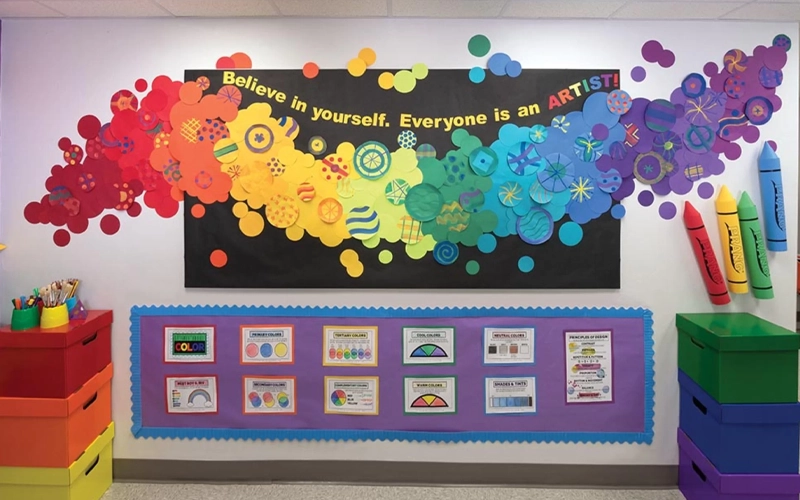
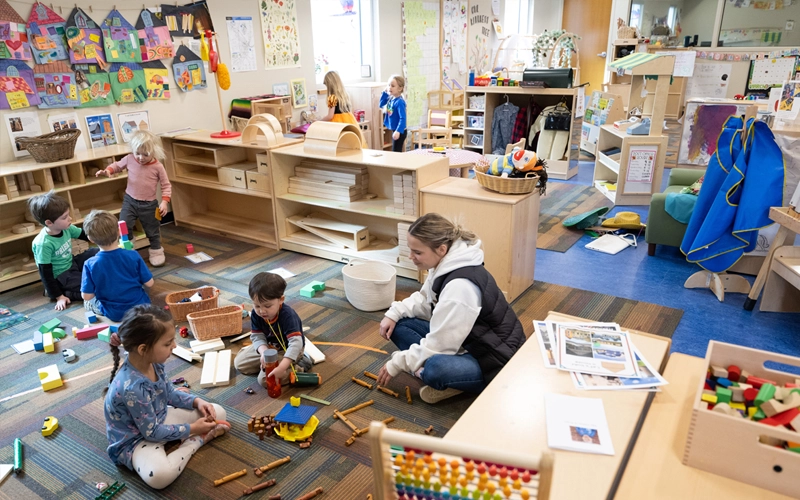
Creating a Stimulating Environment in the Kindergarten Classroom
Use of Color and Light
Color and light play a significant role in creating an inviting and stimulating kindergarten classroom environment. Bright, cheerful colors can enhance mood and engagement, while natural light has been shown to improve focus and overall well-being. In a well-designed kindergarten classroom, strategic use of color can also aid in organization, with different colors designating different areas or activities. For example, you can use blue for reading corners, green for art areas, and yellow for play zones. This makes the classroom visually appealing and helps children navigate the space more effectively.

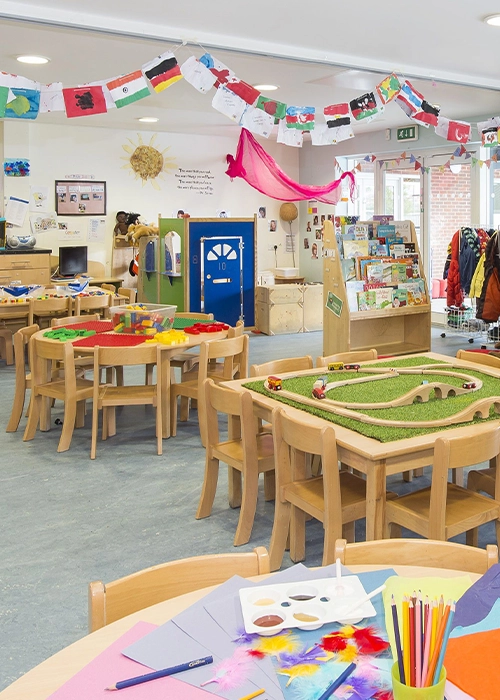
Interactive and Hands-On Learning Areas
Kindergarten students learn best through play and exploration. Incorporating interactive and hands-on learning areas in the kindergarten classroom can stimulate creativity and critical thinking. Sensory tables, building blocks, and art stations are excellent additions that encourage experimentation and discovery. These areas should be easily accessible and stocked with materials that inspire curiosity and hands-on learning. Providing diverse and engaging resources fosters an environment where children are eager to explore and learn.
Displaying Student Work
Displaying students’ work prominently around the kindergarten classroom boosts their self-esteem and creates a sense of ownership and pride in their learning environment. Bulletin boards, wall displays, and hanging projects from the ceiling can showcase children’s efforts and achievements, fostering a community atmosphere. This practice encourages children to take pride in their work and promotes a sense of accomplishment. Additionally, it allows parents and visitors to see the creative and educational activities happening in the classroom, reinforcing the value of the students’ efforts.
Creating a stimulating environment in the kindergarten classroom is essential for nurturing minds. By carefully considering the use of color and light, incorporating interactive and hands-on learning areas, and proudly displaying student work, you can create a vibrant and engaging space that supports children’s development and love of learning.
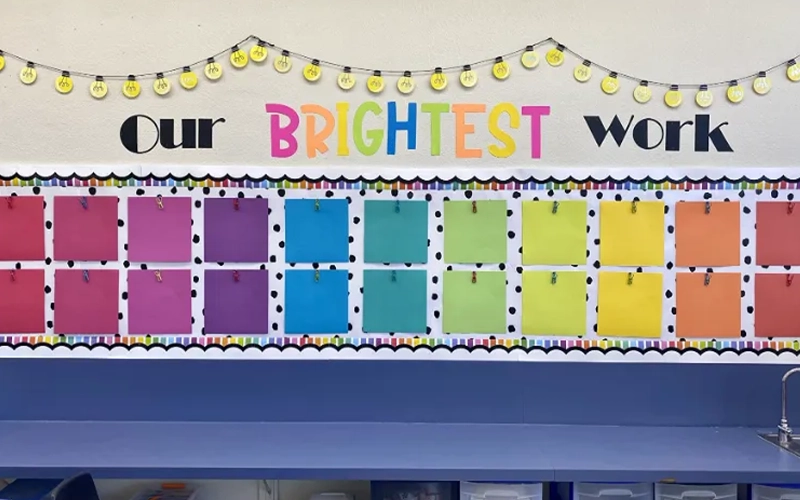
Top Organizational Strategies for Kindergarten Classrooms
Effective Storage Solutions
Clutter can distract and overwhelm children, impacting their ability to focus and learn. Implementing effective storage solutions in the kindergarten classroom is essential to maintaining an organized and tidy environment. Utilize cubbies, bins, and shelves to store various materials and supplies. By clearly labeling storage units, you can teach children responsibility and independence as they learn to put away their materials afterward. Transparent bins can also be helpful, allowing children to see and access the contents and promoting self-sufficiency efficiently.
In addition to traditional storage, consider multifunctional furniture that offers hidden storage compartments. These can store seasonal items, extra supplies, or teacher resources, keeping the kindergarten classroom clutter-free and well-organized. Regularly rotating materials based on the curriculum can also keep the classroom fresh and engaging for students.
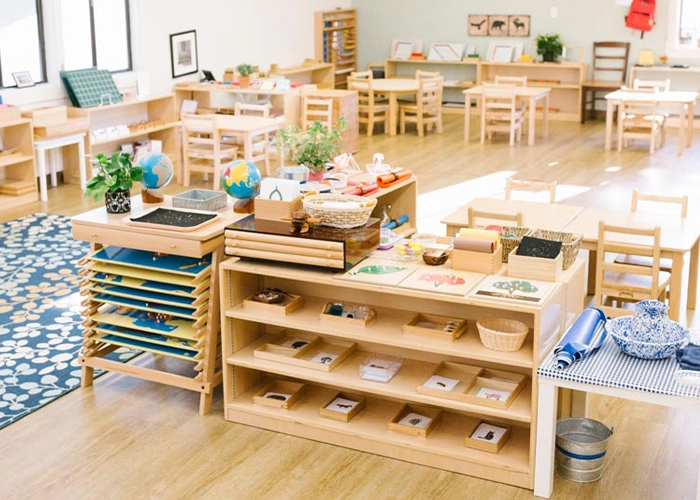


Creating Distinct Activity Zones
Designing distinct zones for various activities can significantly enhance learning and minimize distractions in the kindergarten classroom. Creating specific areas for reading, art, science, and play allows children to focus on particular tasks without interference. For example, a cozy reading nook with soft furnishings and a bookshelf can provide a quiet space for individual reading. An art zone with easels, paint, and craft supplies encourages creativity, while a science zone with experiment stations and discovery tables promotes curiosity and hands-on learning.
Clearly defined zones help children understand the purpose of each area, encouraging them to engage in various activities throughout the day. Additionally, visual cues such as rugs, furniture arrangements, and color coding can further delineate these zones, making the kindergarten classroom more navigable and organized. This structured environment supports a balanced and comprehensive learning experience, catering to different learning styles and interests.
Practical storage solutions and well-designed activity zones are crucial for maintaining an organized and stimulating kindergarten classroom. By implementing these strategies, you create a space that supports learning and fosters independence, creativity, and a love for exploration.


Promoting Social and Emotional Learning in the Kindergarten Classroom

Creating Cozy Reading Nooks
Creating cozy reading nooks in the kindergarten classroom with comfortable seating and various books can encourage a love of reading and provide a quiet retreat for children who need a break from more active play. These nooks can also serve as a space for one-on-one reading sessions between teachers and students. Adding soft cushions, bean bags, and a diverse selection of age-appropriate books can make the nook inviting and engaging. Additionally, themed decorations can make the reading corner more attractive, fostering an early interest in literature.
Designing Inviting Circle Time Areas
Circle time is a staple in kindergarten classrooms, allowing children to develop social skills and participate in group discussions. Designing a dedicated circle time area with rugs or mats helps create a welcoming space where children can gather for storytelling, songs, and group activities. This space should be large enough to accommodate all students comfortably, allowing them to sit in a circle and see each other. Visual aids like charts, storyboards, and interactive elements can enhance the circle time experience, making it more engaging and educational.

Integrating Age-Appropriate Technology
Technology, when used thoughtfully, can enhance learning in kindergarten classrooms. Age-appropriate tech tools, such as tablets with educational apps, can support interactive learning and skill development. Choosing technology that is intuitive and safe for children is essential. For example, tablets with sturdy cases and parental controls can ensure a safe and durable learning experience. Educational apps focused on literacy, math, and creativity can provide additional resources for teachers to incorporate into their lesson plans. Interactive whiteboards can also be a valuable tool for group learning activities.
Incorporating these elements into the kindergarten classroom design enhances the learning environment and supports children’s social and emotional development. By creating cozy reading nooks, dedicated circle time areas, and integrating age-appropriate technology, educators can provide a well-rounded and enriching experience for their students.

Promoting Inclusion and Diversity in the Kindergarten Classroom
Culturally Responsive Classroom Design
A culturally responsive kindergarten classroom design celebrates diversity and inclusivity, creating an environment where every child feels valued and respected. Incorporating multicultural materials, books, and decorations reflects the backgrounds and experiences of all students. This approach fosters a sense of belonging and encourages children to appreciate different cultures. For example, displaying art from various cultures, using books representing diverse characters and stories, and incorporating music and traditions worldwide can make the kindergarten classroom more inclusive and engaging.
Including family photos and community maps can also help children see their personal experiences reflected in the classroom. Teachers can plan lessons that explore different cultural holidays and traditions, promoting understanding and respect among students.
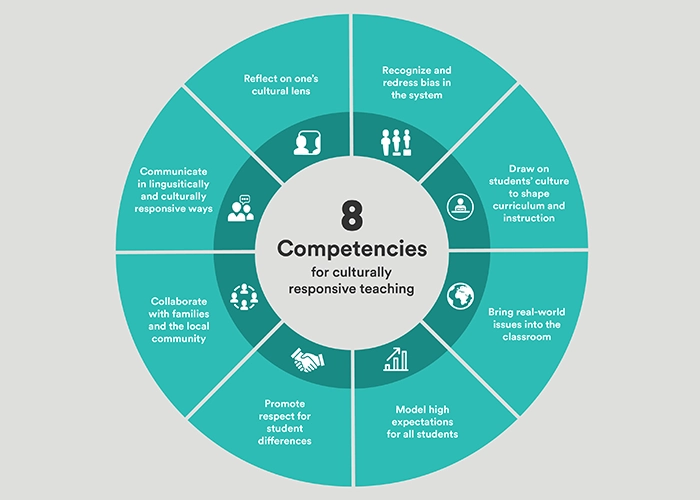
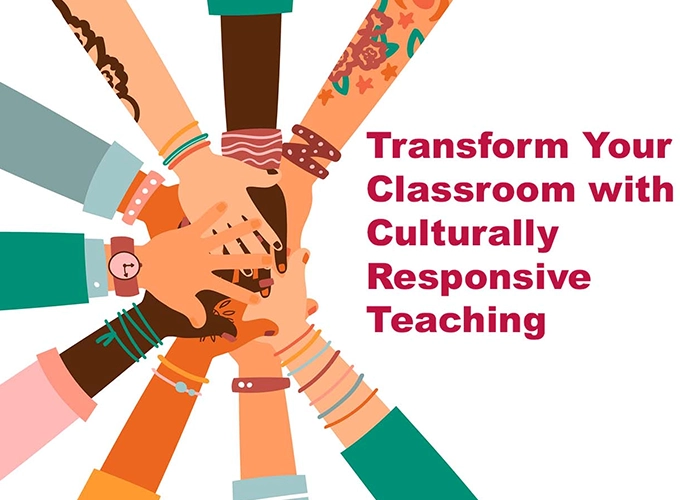
Supporting Special Needs Students
Designing a kindergarten classroom that supports special needs students involves creating an inclusive environment where all children can thrive. This might include providing sensory-friendly areas, adaptive furniture, and visual aids. Sensory-friendly areas with soft lighting, calming colors, and quiet spaces can help children who might feel overwhelmed by the typical classroom environment. Adaptive furniture, such as adjustable tables and chairs, ensures that every student is comfortable and can participate fully in activities.
Collaborating with specialists, such as occupational therapists and special education teachers, is crucial for meeting each student’s unique needs. Individualized education plans (IEPs) allow teachers to tailor their instruction and classroom setup to support the learning and development of special needs students. Visual aids like picture schedules and communication boards can help children with different learning styles understand routines and expectations.
By promoting inclusion and diversity through culturally responsive design and support for special needs students, kindergarten classrooms can become nurturing environments where all children feel accepted and empowered to learn. These strategies not only benefit individual students but also enrich the classroom community as a whole.
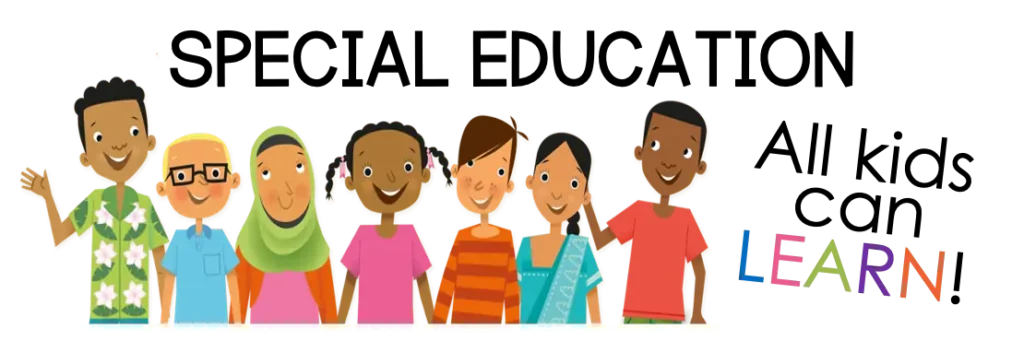
Enhancing Outdoor Learning Spaces in the Kindergarten Classroom
Designing Safe Outdoor Areas
Outdoor learning spaces provide children with invaluable opportunities for physical activity and exploration. Designing safe outdoor areas in the kindergarten classroom involves installing age-appropriate playground equipment, secure fencing, and shaded regions. Ensuring the playground equipment is suitable for children helps prevent injuries and encourages safe play. Secure fencing keeps the outdoor area safe from external dangers, and the shaded regions protect children from sun exposure, making the space usable throughout the day.
Incorporating natural elements like sand, water, and plants can significantly enhance the outdoor learning experience. Sandpits for digging, water tables for sensory play, and garden beds for planting can make the outdoor space educational and enjoyable. These elements provide hands-on learning opportunities that connect children with nature and promote physical and cognitive development.
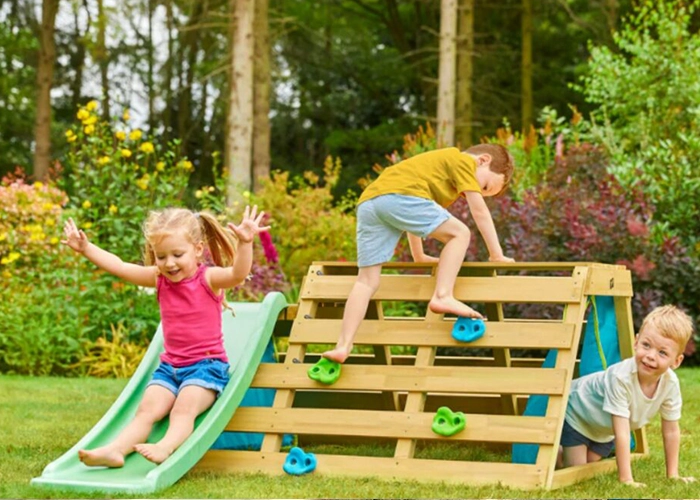
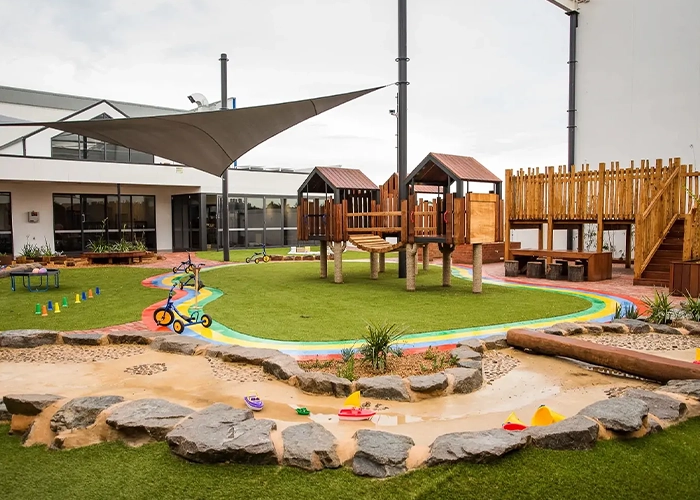

Incorporating Nature into Learning
Bringing elements of nature into the kindergarten classroom creates a calming and engaging environment. Nature-based activities, such as gardening projects, nature walks, and outdoor science experiments, help children develop an appreciation for the natural world. These activities can also support lessons in various subjects, including science, math, and art. For example, gardening projects teach children about plant life cycles, counting, and measuring, while nature walks can be used to explore local ecosystems and habitats.
Incorporating natural materials like leaves, rocks, and flowers into art projects can inspire creativity and help children learn about textures, colors, and natural patterns. Outdoor science experiments like observing weather changes or studying insects make learning interactive and fun, encouraging curiosity and critical thinking.
Educators can create a dynamic learning environment that supports children’s physical, emotional, and intellectual growth by designing safe outdoor areas and incorporating nature into the kindergarten classroom. These strategies provide children with unique learning experiences that foster a love for nature and encourage active exploration.

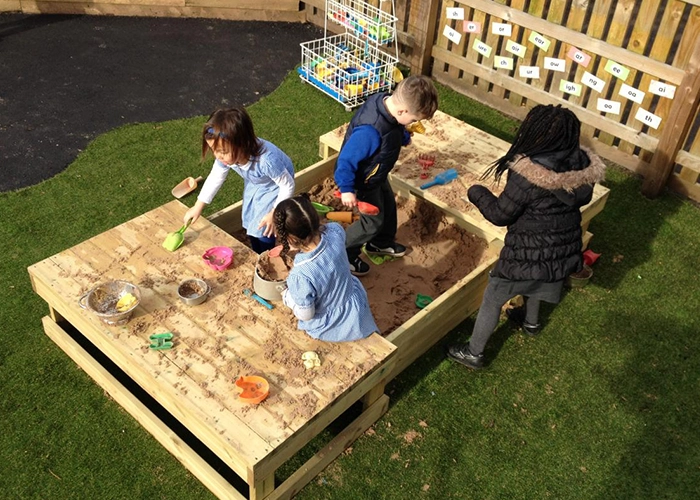
Effective kindergarten classroom design is a multifaceted process that requires careful consideration of safety, accessibility, and engagement. By incorporating best practices, educators can create a learning environment that supports children’s academic, social, and emotional development. A well-designed classroom fosters creativity, collaboration, and a love of learning, setting the foundation for a successful educational journey.

